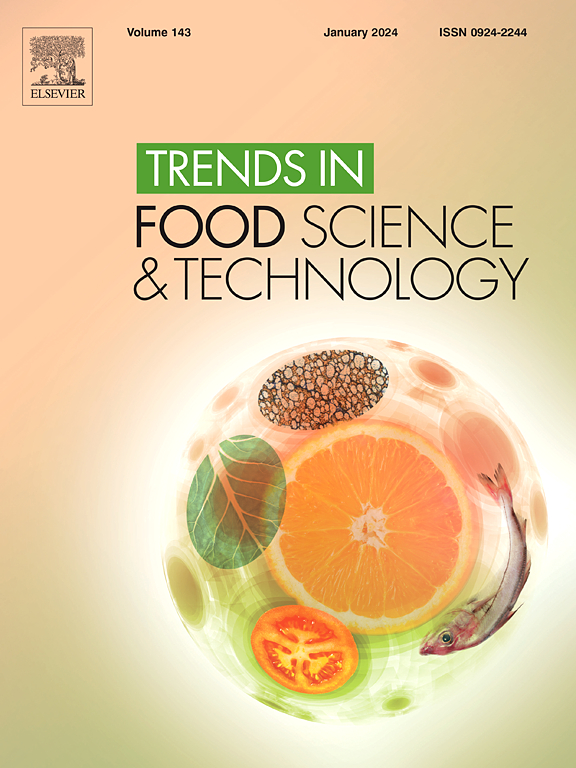Development of cultivated fish meat: Advances in cellular agriculture, biomaterials, and scaffolding techniques
IF 15.1
1区 农林科学
Q1 FOOD SCIENCE & TECHNOLOGY
引用次数: 0
Abstract
Background
Global demand for fish protein is rising amid the depletion of wild fish stocks and the environmental impact of aquaculture, driving the need for sustainable alternatives. Cultivated fish meat, produced via tissue engineering techniques, shows promise for addressing overfishing and contamination concerns while ensuring high-quality protein.
Scope and approach
This review examines key elements of cultivated fish meat production. We analyze suitable cell types, including pluripotent stem cells and muscle satellite cells, and explore plant- and animal-derived biomaterials that mimic fish-specific extracellular matrices. Scaffold fabrication strategies—molding, 3D printing, and microcarriers—are evaluated for their effectiveness in fostering cell adhesion, proliferation, and differentiation. Additionally, we discuss the challenges and prospects of scaling production, particularly bioreactor optimization, cost-effective culture media, and regulatory considerations.
Key findings and conclusions
Plant- and animal-based scaffolds can closely replicate fish muscle architecture, thereby enhancing cellular growth and tissue organization. Emerging techniques, such as dynamic scaffolds and AI-guided precision fabrication, further refine texture and nutritional profiles. Overcoming market barriers requires transparent communication of cultivated fish meat's environmental and health benefits, alongside rigorous regulatory frameworks to ensure safety and quality. Future progress hinges on collaborative efforts among governments, industries, and research institutions to standardize manufacturing protocols and promote public acceptance. If these challenges are met, cultivated fish meat could significantly reduce overfishing, lower greenhouse gas emissions, and offer a viable route toward global food security.
养殖鱼肉的发展:细胞农业、生物材料和支架技术的进展
在野生鱼类资源枯竭和水产养殖对环境造成影响的背景下,全球对鱼类蛋白的需求正在上升,推动了对可持续替代品的需求。通过组织工程技术生产的养殖鱼肉有望解决过度捕捞和污染问题,同时确保高质量的蛋白质。范围和方法本文审查了养殖鱼肉生产的关键要素。我们分析了合适的细胞类型,包括多能干细胞和肌肉卫星细胞,并探索植物和动物来源的生物材料,模拟鱼类特异性细胞外基质。支架制造策略-成型,3D打印和微载体-评估其在促进细胞粘附,增殖和分化方面的有效性。此外,我们还讨论了规模化生产的挑战和前景,特别是生物反应器优化、具有成本效益的培养基和监管方面的考虑。基于植物和动物的支架可以很好地复制鱼类肌肉结构,从而促进细胞生长和组织组织。新兴技术,如动态支架和人工智能引导的精密制造,进一步改善了质地和营养状况。克服市场障碍需要透明地宣传养殖鱼肉的环境和健康效益,同时需要严格的监管框架来确保安全和质量。未来的进展取决于政府、行业和研究机构之间的合作努力,以使制造协议标准化并促进公众接受。如果能够应对这些挑战,养殖鱼肉可以显著减少过度捕捞,降低温室气体排放,并为实现全球粮食安全提供一条可行的途径。
本文章由计算机程序翻译,如有差异,请以英文原文为准。
求助全文
约1分钟内获得全文
求助全文
来源期刊

Trends in Food Science & Technology
工程技术-食品科技
CiteScore
32.50
自引率
2.60%
发文量
322
审稿时长
37 days
期刊介绍:
Trends in Food Science & Technology is a prestigious international journal that specializes in peer-reviewed articles covering the latest advancements in technology, food science, and human nutrition. It serves as a bridge between specialized primary journals and general trade magazines, providing readable and scientifically rigorous reviews and commentaries on current research developments and their potential applications in the food industry.
Unlike traditional journals, Trends in Food Science & Technology does not publish original research papers. Instead, it focuses on critical and comprehensive reviews to offer valuable insights for professionals in the field. By bringing together cutting-edge research and industry applications, this journal plays a vital role in disseminating knowledge and facilitating advancements in the food science and technology sector.
 求助内容:
求助内容: 应助结果提醒方式:
应助结果提醒方式:


